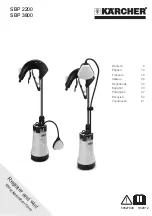
8
Section V – Cartridge Assembly and Installation
Figure 2.
The above illustrates the configurations of small and large series pump cartridge parts. Inset view Figure 3, page 7,
illustrates configuration of the intermediate series cartridge parts. Assembly procedure is the same.
Assembled for Right Hand Rotation
Assembled for Left Hand Rotation
Assembled View
Facing Head End
Bushing
Ring
Rotor
Bushing
Pin
Bushing
Vane
Ring
Vane
Pin
Rotor
Bushing
A. Cartridge Assembly
Figure 2 illustrates a typical cartridge assembly and
installation, when viewed from the head end. The cartridge
assembly procedure is the same for both single and double
pumps, depending on the direction of shaft rotation.
The stepped diameter locating pin prevents improper assem-
bly of the cartridge. However, caution must be exercised to
install the cartridge properly for the direction of rotation desired.
The large series pump cartridges have a locating screw and a
retaining screw in lieu of the locating pin used in the small and
intermediate series.
NOTE
The direction of rotation (right hand or left hand) is
always determined by viewing the pump from the
shaft end.
B. Installation
Right Hand Rotation: Insert the small end of the located pin
into the small hole in the pump body at a 3 o’clock position.
Left Hand Rotation: Insert the large end of the located pin
into the large hole in the pump body at a 6 o’clock position.
C. Head Screw Adjustment
Some pump cover heads and intermediate heads (double
pumps) are provided with two small holes to match the two
diameters of the locating pin. Install the head so the pin fits
the hole size to prevent the pin from bending or shearing
when the pump is put into operation.
Pull the head down gradually, alternately tightening the
screws 180
°
from each other until the head seats evenly on
the bushing. Turn the shaft by hand during the process until a
light, smooth snugness is felt through a complete revolution.
Do not over-tighten the screws, causing the shaft to bind.
Before starting these pumps, check for freedom of move-
ment of the internal parts by turning the shaft by hand. Never
start a pump which shows evidence of binding.
CAUTION
A new or overhauled pump must be started under load
on the first rum. This will create a back pressure to
assure adequate internal lubrication. After a pump is
broken in, it can be started under ’’no-load” conditions.






























